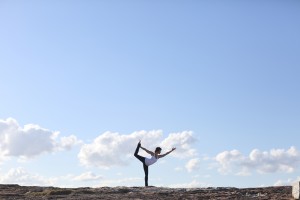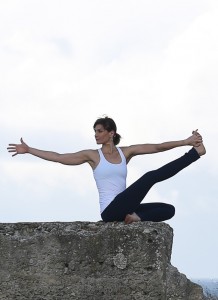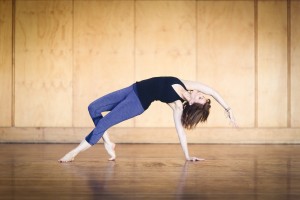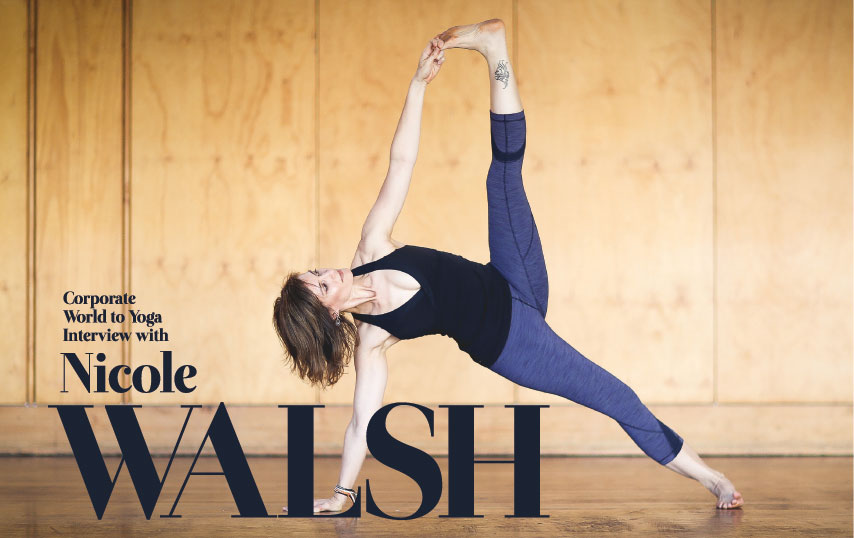1. How did you find out about yoga and start your practice?
I started going to yoga classes with a friend when I was in my 20’s. My friend was recovering from a severe illness, and her doctor suggested she take up yoga. I went along for moral support, and fell in love with it! My friend kept going for a little while, but I was hooked. I had been quite into going to the gym at that time, and initially I figured that stretching was a good idea. Quite soon I started to see huge changes in myself – both in the physical and psychological sense. I also started to feel much more relaxed within myself and at ease with life. The things that usually worried me or caused stress didn’t seem to have so much of an impact. After a few months of going to yoga classes regularly I cancelled my gym membership and yoga became my daily sanctuary.
 2. You initially worked in the corporate world, at what point did you decide that you wanted to teach?
2. You initially worked in the corporate world, at what point did you decide that you wanted to teach?
I remember quite clearly the day I realized that yoga had become such an important part of my life, that it was a non-negotiable. My daily routine revolved around getting to work early so I could leave early to get to my yoga classes! I thought about how I enjoyed spending my time, and it was becoming quite obvious to me (and to everyone around me) that sitting at a desk for 8 hours a day was not making me happy. Yoga was the part of my day that brought me great joy and peace, so it was a natural decision for me to decide to become a yoga teacher, and one that I’ve never regretted.
3. On top of Power Vinyasa Yoga, which was introduced in Australia by you, do you practice other styles of Yoga?
I’ve explored many different styles of yoga over the years, from Bikram to Ashtanga, and Power Yoga to Yin yoga and everything in between! For a long time my true love has been Vinyasa – mainly because it can be adapted to address the changing needs of my body and mind. Some days I’ll practice more dynamically when I’m feeling energetic, and other days my practice will be more a ‘lunar flow’ – restorative and regenerative – but still with the emphasis on breath-inspired movement. Yin is also something that I love exploring. It’s a great complement to a moving practice, and I love the meditative quality I’m able to tap into. Meditation is also an important part of my personal practice.
4. What was your teaching style in the early stage and how did it evolve?
My first teacher training was Bikram – and my first studio was a Bikram studio! Initially my teaching was quite structured, following the Bikram class format. But I wasn’t satisfied with teaching the same thing the same way every time, so I don’t think I ever really fit the Bikram mould – I had a real problem with telling students they should ‘lock the knee’ and ‘bend way back, until your back hurts like hell’ as the Bikram dialogue dictated. Bikram teachers follow a script or ‘dialogue’ and they are not meant to deviate from it!
While I was in the process of starting my studio in 2002 I began studying a 2 year Diploma of Yoga at Nature Care College in Sydney. I had some wonderful teachers there (Mark Breadner, Michael de Manincor, Eve Gryzbowski to name a few) and it was a course that addressed the depth and breadth of yoga. It really opened my eyes to all that yoga could offer. It was my ‘real’ yoga education and it helped me clarify the direction I wanted to take as a yoga teacher. During the same period of time I started studying with Baron Baptiste, whose best-selling book, ‘Journey Into Power’ became like a bible to me. Baron’s style of teaching really lit my fire, no-one was teaching Power Yoga in Australia, and it became a platform for me to share everything I loved, and everything I had been learning about yoga. I started teaching the style at my studio, and it was received really well! Pretty soon I switched half the classes on the schedule at my studio from Bikram to Power Yoga, and over time as people began to resonate more strongly with that type of practice, I decided to convert to being solely a Power Yoga studio.
 Ten years ago I met Shiva Rea, who I consider to be my main teacher. Her fluid style of practice that she calls ‘Prana Flow’ is an embodiment of the flow of energy within movement and life itself. It took my practice from being quite ‘linear’ into a more fluid, circular style of physical movement, which feels so natural to me. My teaching style has definitely headed more into this realm, and I love slowing down the practice so people can really feel – both on a physical and emotional level. This way of practicing, allowing space to feel the pauses, creates the opportunity for people to connect in a whole new way. I aim to lead people through a process that allows them to shift spontaneously into a restful state where meditation can happen.
Ten years ago I met Shiva Rea, who I consider to be my main teacher. Her fluid style of practice that she calls ‘Prana Flow’ is an embodiment of the flow of energy within movement and life itself. It took my practice from being quite ‘linear’ into a more fluid, circular style of physical movement, which feels so natural to me. My teaching style has definitely headed more into this realm, and I love slowing down the practice so people can really feel – both on a physical and emotional level. This way of practicing, allowing space to feel the pauses, creates the opportunity for people to connect in a whole new way. I aim to lead people through a process that allows them to shift spontaneously into a restful state where meditation can happen.
5. In a class full of people with different aims, how do you strive to keep everyone engaged and motivated?
I generally start the class by having everyone sit together for a few collective breaths, where people can start to feel a sense of rhythm and synchrony. This is really helpful for the group dynamic of a class. Sometimes I’ll have a central theme, or focus, or intention that gives a purpose to the practice. I don’t always announce the theme, it’s more ‘back of house’, and helps me create a vibe and language that helps the class flow and progress towards a goal. Humour is also important in keeping it light so people don’t end up getting too serious! Acknowledging individuals during the class through hands-on assisting and offering encouraging comments allows me to create a rapport with individuals and the whole class at the same time. Students need to know that their teacher notices them and the evolution of their practice, so I do my best to give positive and encouraging feedback to them as much as possible. My aim is to have some kind of connection with each person, whether it’s eye contact, or a specific verbal cue, or a physical hands-on assist.
6. What qualities do you think someone should look for in a yoga teacher or studio?
Ideally you want to find a teacher who is firmly established in his or her own practice and is a sincere student of yoga. I believe that to be a good teacher you need to be a good student. You also want someone who is approachable, has integrity and has a genuine interest in helping the people they are teaching. It’s also inspiring to learn from someone who allows their humanness and personality shine through with warmth and compassion, and who takes the time to connect authentically with their students. If you’re seeking out a studio, then you would want the teachers to embody the above qualities.
7. What would you say to someone who thinks yoga is not for them?
I personally believe that yoga is for every body. Yoga is so vast, there are so many styles and ways to practice, there really is something for everyone. The first step in removing the obstacles to yoga is busting the myths that people have about yoga that lead to them thinking that yoga is not for them. A few of the biggest reasons people give for not taking up yoga are: “I’m not flexible enough” or “My mind is too busy to practice yoga”… these are exactly the reasons why someone SHOULD start practicing yoga!
 8. What does ‘perfect alignment’ mean to you? What approach do you use to assist students in terms of alignment?
8. What does ‘perfect alignment’ mean to you? What approach do you use to assist students in terms of alignment?
The idea that there is perfect alignment is the first problem! Expecting your students to look like the text book images of a yoga asana is likely to create a situation where someone feels they are somehow flawed, or “no good” at yoga. I love yoga teacher and author Leslie Kaminoff’s saying: “Poses don’t have alignment, people do.” Hearing that little nugget of gold changed the way I taught asana. While there is a certain shape the roughly determines the pose, and there are certain biomechanical considerations to keep people safe and prevent injury, the actual nuances of alignment are very individual. A “one-size-fits-all” approach to alignment doesn’t work. This understanding makes it challenging for teachers who teach large group classes, as it takes a lot of skill to ensure everyone is getting what they need from a practice.
The approach I use is to understand the function of an asana, e.g. what is the intention and the key action in an asana. This helps me to see what level of awareness a insuflaveis student has in their body, and this guides me when it comes to assisting someone. Assisting someone in their yoga practice is a verbal and non-verbal communication with a human being, with the goal being for the person to discover more about themselves physically, mentally, emotionally – not to have the “perfect posture”.
9. You have an in-house physiotherapist in the studio. Do you think yoga and physiotherapy go hand in hand and why?
I think yoga goes hand in hand with most physical therapies and bodywork. For people to move towards balance and health, taking an integrated approach is important. I believe yoga is a wonderful antidote to the stresses we wear day to day, and can certainly help with chronic problems, but if there is an injury or some kind of dysfunction, having a professional to treat specific conditions will help the person on the road to healing much more effectively. We’re so lucky at InYoga to work with two amazing physiotherapists, Darcy and Rachel, both of whom are also yoga teachers. Often people sustain injuries that prevent them from practicing, and if a physio tells them they should stop yoga, that news can be quite devastating. Getting the right advice on how to modify and adapt a practice so people stay connected to what they love is key in their healing process.
10. What advice do you wish you could tell your younger self?
One of the things I’ve learned as I’ve gotten older has been to trust myself and my instincts more. When I was younger I often had that feeling that I wasn’t good enough, or didn’t know enough, so I would second guess myself or doubt myself. I guess that’s pretty normal as a young person making your way in the world .. but I would say “Have no fear, and trust yourself.”
11. Where do you turn to when you’re in need of some creative inspiration?
Generally when I’m in need of some inspiration I’ll get on my mat. Either to practice on my own and move my body and see what comes up, or I’ll go and take a class where I can just be a student. I’m also a book lover – I have quite a collection both in hard copy and on my Kindle. My favourite titles to bring inspiration into my yoga classes are The Radiance Sutras (Lorin Roche), Tending the Heartfire (Shiva Rea), The Art of Attention (Elena Brower) and anything by Marianne Williamson. Taking time out to recharge is also a big part of staying inspired. Days off and holidays are essential in preventing ‘yoga teacher burnout’ or ‘yoga studio owner burnout’. I’ve experienced both several times, and the best thing I can do to get the creative juices flowing again is to get out of the city, let my eyes see some greenery and breathe in some fresh air.
12. If you weren’t a yoga teacher, what would you be?
I would be a horse trainer for sure. I have two horses and love being with them, although these days I don’t have nearly as much time for them as I would like! I discovered a program called Parelli Natural Horsemanship, which aims to cultivate a relationship of mutual respect between you and your horse. The principles are very ‘yogic’, and it has some great parallels with yoga philosophy. It’s an incredible feeling when your horse follows you around without a lead, simply because he trusts you. One day I’d love to combine my love of yoga and horses into a really special experience for people – I’m visualizing yoga and horsemanship retreats in the future!
To read the full article please download our Asana Journal App or purchase Issue 161 May 2016.




















 Other
Other